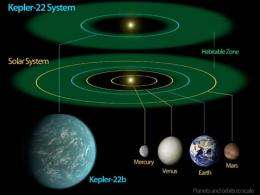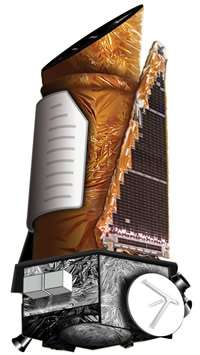Could 2012 be the year we find extraterrestrial life?

Last year came to an exciting end with the discovery of an Earth-like planet, Kepler-22b, orbiting a sun-like star outside of our solar system. It was found by NASA’s Kepler mission and is the first planet detected orbiting in a star’s habitable zone, the region around a star where liquid water, a requirement for life on Earth, could persist.
The Kepler mission also found 9 other near-Earth-size potential planets that orbit in the habitable zone of their host star. And this month, scientists published results of a 6-year study strengthening the possibility that life forms similar to those on Earth exist elsewhere.
So could 2012 be the year to find extraterrestrial life? Investigating Kepler-22b and the other possible planets is certainly a good place to start.
Natural History Museum extra-planetary expert Sara Russell comments on the finds, "These are really exciting new discoveries. It has been one of the main aims in astronomy over the last decade or so to search for Earth-like planets, and it looks as if we are getting nearer that goal.
"Kepler 22b is similar to the Earth in being a similar distance away from its sun, but in some ways it is very different - it is probably much larger than the Earth, and so not an actual "twin"," says Russell.
Scientists do not yet know if Kepler-22b is made up of a rocky, gaseous, or liquid composition. It is about 600 light years away, within our own galaxy, the Milky Way.
What is essential for life?
So, what is needed for life forms to exist? "At the moment our own planet is the only known example of a host for life, so it is difficult to say what is really essential," says Russell.
Most scientists, including Russell, agree that it is important to have water, and so the planet would need to be in the habitable zone, where it is neither too hot nor too cold to have liquid water.

Other factors such as the type of orbit and star are also important. Russell explains, ‘The star around which the planet orbits would need to be stable, and the planet would ideally have a low eccentricity, which means its orbit is close to circular rather than elliptical, which would keep the conditions on the planet more consistent.
'There would also need to be a supply of the elements that are important to make life: carbon, oxygen, hydrogen and nitrogen.’
What kind of life are we likely to find?
Earth has an incredible variety of life, from single-celled amoeba to the mighty whale. So what type of alien life are we likely to find?
"I think that it is very likely that we will find extraterrestrial life in the form of simple, perhaps one-celled, extraterrestrial organisms, says Russell. 'There are many many planets in our galaxy and the basic elements needed for life are very common.
"We would have to be really lucky to find anything more sophisticated. On our planet, single-celled creatures existed for billions of years before more complex life evolved, and our technologically advanced life has only been around for a tiny fraction of the Earth's existence."
Where else are we likely to find life?
If not on Kepler-22b, then where are we most likely to find life, and how will we find it? There are several new generation telescopes that are currently searching for terrestrial-like planets, says Russell.
"I anticipate that over the next few years we will hear about dozens of discoveries of planets that are quite similar to Earth, and many of them may be habitable.
"We also should not dismiss the possibility that there may be life nearer to home, in our own solar system. Some of the moons of Jupiter and Saturn have water and the right temperature regime to host life."
Will we ever see extraterrestrials?
We are unlikely to be able to see life forms that may exist on planets outside our solar system (exoplanets), because they are too far away and we do not yet have the technology to reach such places.
Russell explains, 'The exoplanet searches will only be able to tell us at a very basic level whether there is life or not. For example, we can tell if there are life forms breathing from the composition of the atmosphere, which we can detect using telescopes from far, far away. There is no way we would be able to tell what that life looks like.'
In the meantime, Russell is busy characterizing materials from our own solar system. She studies the diversity of rocks, using meteorites that originate from different parts of our planetary system. This means Russell can better understand what extra-solar planets may be made of and what their geology is like, and therefore decide if they are likely hosts for life.
The Kepler mission is searching only a portion of our own galaxy, to find out how many of the billions of stars have Earth-size planets in or near habitable zones. With 10 possible candidates found so far, the search for alien life is getting closer. When asked what her most likely reply would be if life was found elsewhere, Russell responds, ‘I'd say, "I told you so!"’
Provided by American Museum of Natural History




















